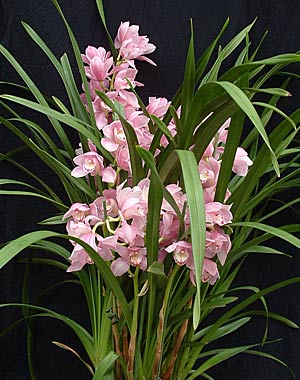
Did you know…
There is a Japanese myth which tells of an emperor’s wife who was heartbroken after remaining barren after many years of marriage. A sage on hearing of her anguish presented to her a white Cymbidium ensifolium.
After just one inhalation of its inebriating fragrance, she fell pregnant and then went on to produce thirteen children in succession!
This orchid became known as “Ju-san-sai-ho” or “orchid of thirteen treasures”.
This is a familiar orchid genera with worldwide appeal and has a long history in cultivation. It is often referred to as the “King of Orchids” and if you have ever seen a standard Cymbidium with multiple stately flower spikes carrying an abundance of 25cm blossoms you will appreciate why. There can be no argument that they are peerless amongst orchids in terms of making their presence felt.
The majority of Cymbidiums commercially available are hybrids derived from around six species which chiefly originated from the foothills of the Himalayas. They are categorised into miniatures, semi-standards and standards based upon their height ranging from 15cm to in excess of 1.5m.
Cymbidiums are mostly very easy to grow but have a reputation of being difficult to re-flower. In order to achieve flowering every year, the plants must be kept cool during the summer, receive regular watering, heavy feeding and plenty of sunshine. In autumn they must have cool nights and bright days to initiate flower spikes. All that been said some varieties flower more easily than others. Without hesitation they can be recommended to the beginner but be aware that a standard Cymbidium is of a monstrous size so be selective about the ones you choose.
Temperature
Cool (Night temperatures of between 10° and 12°C with a daytime rise of about 10°C). Temperatures down to 6°C or even less present no problems for most during the winter providing the roots are kept on the dry side. Many also thrive better outdoors during summer rather than grown under glass.
Light
High (bright indirect).
Watering
Plentiful during the summer but reduced after the large pseudobulbs have fully fattened in the autumn. They have extensive roots and can even break open their containers to demand repotting! They benefit from frequent misting during the summer which helps reduce red spider mite infestations.
Feeding
High compared to other orchids. Use a standard strength high nitrogen fertiliser to boost their substantial vegetative growth in the summer and one with high potassium in the autumn to encourage flower spike development.
